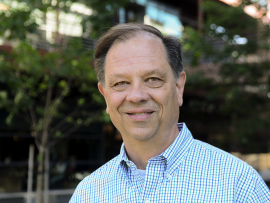
William T. Newsome, Director of the Stanford Neurosciences Institute
Interdisciplinary Scholars
Postdoctoral fellows are among the most valuable and productive members of any life sciences research program. Talented postdocs bring a level of experience, judgment and technical sophistication to the laboratory that drives science forward in unique ways. Premier universities and research institutes are keenly aware of this fact, as evidenced by the near-universal practice of hiring young faculty from the ranks of postdoctoral scholars.
While postdoctoral training has always provided an opportunity for recent Ph.D.’s to acquire new research perspectives and skills, ambitious cross-disciplinary training is increasingly crucial for today’s young researchers who will shape 21st century brain science. As I say every time I have the chance, understanding the brain is no longer just a problem in biology, if indeed it ever was. The best neuroscience research of the future will incorporate concepts, techniques, and analytic approaches from a host of disciplines.
Recognizing the critical contributions made by our postdocs and the importance of advanced postdoctoral training, the Stanford Neurosciences Institute developed our Interdisciplinary Scholar Awards. The awards provide funding to extraordinary postdoctoral scientists at Stanford engaging in highly interdisciplinary research in the neurosciences, broadly defined. Six Interdisciplinary Scholars were announced in 2015, and the competition for the 2016 round of awards is currently underway. See our CALL FOR APPLICATIONS
Let me briefly introduce our current interdisciplinary scholars, who hail from departments in the schools of Medicine, Humanities & Sciences and Engineering. Each of these scientists has a team faculty advisors from different fields of research.
Lei Cai (Materials Science & Engineering) is designing hydrogel materials to cradle delicate stem cells and protect them during injection into the spinal cord. Facilitating the transplantation of healthy stem cells could advance regenerative therapy for spinal cord injury patients.
Audrey Fan (Radiology) exploits simultaneous MR-PET scanning to establish new, improved methods for noninvasive imaging of cerebral blood flow. A successful outcome would greatly facilitate diagnosis and treatment of patients at high risk for stroke.
Whitney Heavner (Biology) combines molecular biology with computational genomics to identify the complete set of transcription factors and target genes necessary for ensuring that different types of neurons develop properly and connect with the correct targets. A better understanding of how the brain gets wired during development will lay a foundation for improved treatment of many developmental disorders of the nervous system.
Rupa Lalchandani (Neurosurgery) investigates the relationship between dopamine and GABA synthesis, vesicular packaging, and co-release in basal ganglia neurons. Rupa aims to elucidate the role of inhibition throughout the nervous system, potentially providing better tools and earlier targets for diagnosing and treating disease.
Christoph Leuze (Radiology) is applying the CLARITY technique to human brain tissue that is analyzed in parallel by diffusion-weighted magnetic resonance imaging (dMRI) with the goal of understanding and validating the structural resolution achievable with dMRI.
Kevin Mann (Neurobiology) aims to decipher the cellular and physical basis of magnetosensation in animals, using fruit flies as a model system and focusing on the light-dependent cryptochrome protein as a molecular magnetometer. Understanding how magnetic energy interacts with the nervous system could lead to new methods of noninvasive circuit manipulation.
I congratulate these scholars, and I look forward to meeting five more in the near future. A special word of thanks goes to Prof. Miriam Goodman who is directing this SNI program, and to the SNI faculty members who reviewed the applications.
Finally, please mark your calendars for the second annual SNI symposium on October 1, which will be held this year in Berg Hall, LKSC. We have a sterling line-up of speakers, as well as posters from Stanford postdocs and grad students. Come meet your colleagues and enjoy the science!
William T. Newsome, Ph.D.
Vincent V.C. Woo Director, Stanford Neurosciences Institute
Harman Family Provostial Professor
Professor of Neurobiology, HHMI Investigator



